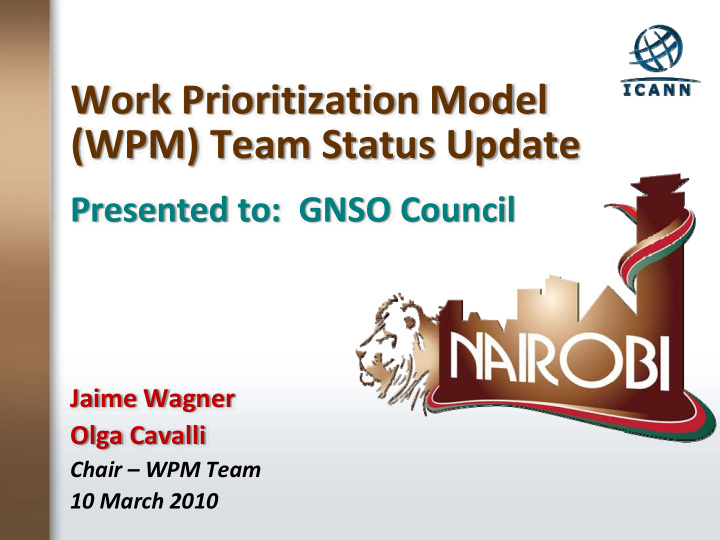



Work Prioritization Model (WPM) Team Status Update Presented to: GNSO Council Jaime Wagner Olga Cavalli Chair – WPM Team 10 March 2010
Why Was A WPM Effort Undertaken? � Pre ‐ Seoul Community Symptoms: ‐ Work teams struggling to complete tasks ‐ Conference calls cancelled due to lack of participants Source: GNSO Participation & Workload Study ‐‐ Presented by Liz Gasster to GNSO Council, Seoul
Staff Attendance Study (Oct 2009) Causes? Source: GNSO Participation Study, ICANN Staff, 26 October 2009
Study Conclusion “There is clear evidence of sporadic attendance and, in some cases, very low participation by some Constituencies and inconsistent participation by others. “ Source: GNSO Participation & Workload Study ‐‐ Presented by Liz Gasster to GNSO Council, Seoul
Study Questions For Further Analysis 1) How might the GNSO’s work be prioritized? 2) Is there too much GNSO work and, if so, what might be done to assess the total capacity? 3) Are Constituencies providing enough recruits to the groups being formed? 4) What levels of group participation should be targeted for each Constituency? Work Prioritization Model (WPM) Team Source: GNSO Participation & Workload Study ‐‐ Presented by Liz Gasster to GNSO Council, Seoul
WPM Formed early November 2009 � Initial Activities: – Scoping the Effort Active Staff/Team Concept Sharing & Discussions – Six Step Plan: Concept � Adoption 1) Finalize the Project List and Descriptions 2) Solidify Definitions 3) Develop & Test Rating/Ranking Methodology 4) Produce Test Results 5) Evaluate Results, Model Construct, Process, and Methodology 6) Focus on Outcomes, i.e. HOW Council might utilize the prioritization outputs to address original workload concerns
WPM Decisions Confirmed � Project List Completed � Model Simplification: Focus Primarily on Value � Definitions Completed � Rating Methodology Tested & Adopted Thus Far: – Scale: 7 Point “Likert” – Individual Rating Template – Group DELPHI Process using Adobe Connect with Polling Feature � Outcomes: How Is Prioritization Useful? – Education & Transparency: communicates Council’s work priorities to establish organizational awareness and understanding – Resource Allocation: may help the Council redirect limited resources where needed – Strategic Management: Councilors may be informed by the project prioritization when discussing issues and voting on particular motions
WPM Next Steps � Continue Methodology Evaluation � Decide if Additional Testing is Needed � Management Tools Recommendation – Prioritization is useful, but not ‘quick fix’ by itself – Council needs data and management tools to assist in decision ‐ making � Document Final Model and Methodology � Council Training Materials � Deliverable to Council Targeted � 13 April Note: Deliverable timed to be 8 days in advance of 21 April 2010 Council meeting.
Thank You!
Recommend
More recommend